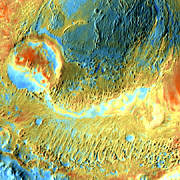Western Arabia Terra is a sprawling, ancient landscape on Mars rich in craters, impact debris, and features shaped by the effects of wind on rock, sand, silt, and dust.
The nameless crater seen here spans 85 kilometers (53 miles). It lies about 350 km (220 mi) northwest of the spot on Meridiani Planum where NASA landed the rover Opportunity in January 2004. But unlike that broad flatland, this scene is a lot rougher. It has more in common with another scene lying a thousand kilometers to the east.
This false-color image was made by combining photos taken at infrared wavelengths during local daytime and late at night. The camera was
THEMIS, the Thermal Emission Imaging System, aboard NASA's Mars Odyssey orbiter. Broadly speaking, the colors indicate surface materials, with redder colors showing where rocks and hardened sediments are commonest. Tints of greens and blues map the places where finer-grain materials - sand, silt, dust - cover the surface.

Carving Knife
Like many large craters in Arabia, this one has a big mound in the middle. This may be the remnant of a central peak, a common feature in impact craters this size and larger. Yet it's more likely to be the eroded remnant of a sedimentary layer deposited in some way. (The sediments could also be concealing a central peak.) The crater dates from the Noachian period, Martian history's oldest. The Noachian runs from the planet's formation about 4.6 billion years ago until about 3.9 billion years ago.
The crater is old enough that its central mound shows at least two almost-eradicated craters. Across the interior, younger sediments partly cover the crater's floor. These may have been deposited by the wind or water, or both. Whatever the case, the layer has been partly removed in a streaky pattern which offers a clue as to how it eroded.
People speak of cold winds that "cut like a knife." In the desert regions on Mars, as on Earth, this can be more than just a figure of speech.
Winds build dunes as they carry loose particles of sand and grit downwind, heaping them one by one into slowly shifting piles. Yet where the ground is soft enough, wind-driven grains don't accumulate - they etch the surface, carving features into it that often form long, streamlined ridges.
Geologists call such features yardangs, and note that the upwind ends are usually steeper and blunter, while the downwind ends taper away gently.
The yardangs inside the outer crater rim rise about 20 m (65 ft) and appear spaced roughly a kilometer (half a mile) apart, while those on the central mound clump more tightly and appear shallower. This may come from differences surface materials - where the ground is tougher, small yardangs develop.

Layer Upon Layer
The starkly contrasting (false) colors indicate a big difference in the material on the ground. Blues indicate surfaces that are cooler at night. This is generally a clue that dust, loose silt, and fine sand are common there.
Such materials heat quickly during the day, but lose heat rapidly after sunset. (Think of walking barefoot on a beach late at night.) Rocks and harder sediments, however, don't grow as warm by day as fine materials do, yet they lose heat more slowly at night. To the heat-seeking lens of THEMIS looking down from orbit late at night, rocky areas appear brighter than sandy ones.
This wedge-shaped area likely represents a lava flow partly covered with softer sediments - only the reddest parts likely have bare (or nearly bare) rock exposed. Note also that the layer is noticeably smoother than the surfaces adjoining it. Plus it appears to have flowed around, but not covered, a handful of small impact craters.

Three-In-One Crater
Oval or elongated craters usually suggest a volcanic vent, but in this case a clear-cut apron of ejected debris wraps around the "triple crater." This points strongly toward an impact origin.
The crater measures about 23 km (14 mi) east-west and 14 km (8.5 mi) north-south. Its oval rim stands about 200 m (650 ft) above the outside surface, while its floor lies some 800 m (2,600) feet below the rim.
Triple craters such as this are quite rare - doublets are more common, although even those still happen very seldom. Multiple craters result when the impacting body splits into pieces just before it hits. This may occur because the shock of hitting the atmosphere breaks up a fragile impactor.
Planetary scientists note that while many asteroids are likely solid bodies, some appear to be only loosely cohesive - flying rubble piles, in other words. If one such slammed into Mars ages ago, the outcome might look like this: a large central crater flanked by two smaller ones, all formed at the same instant.



